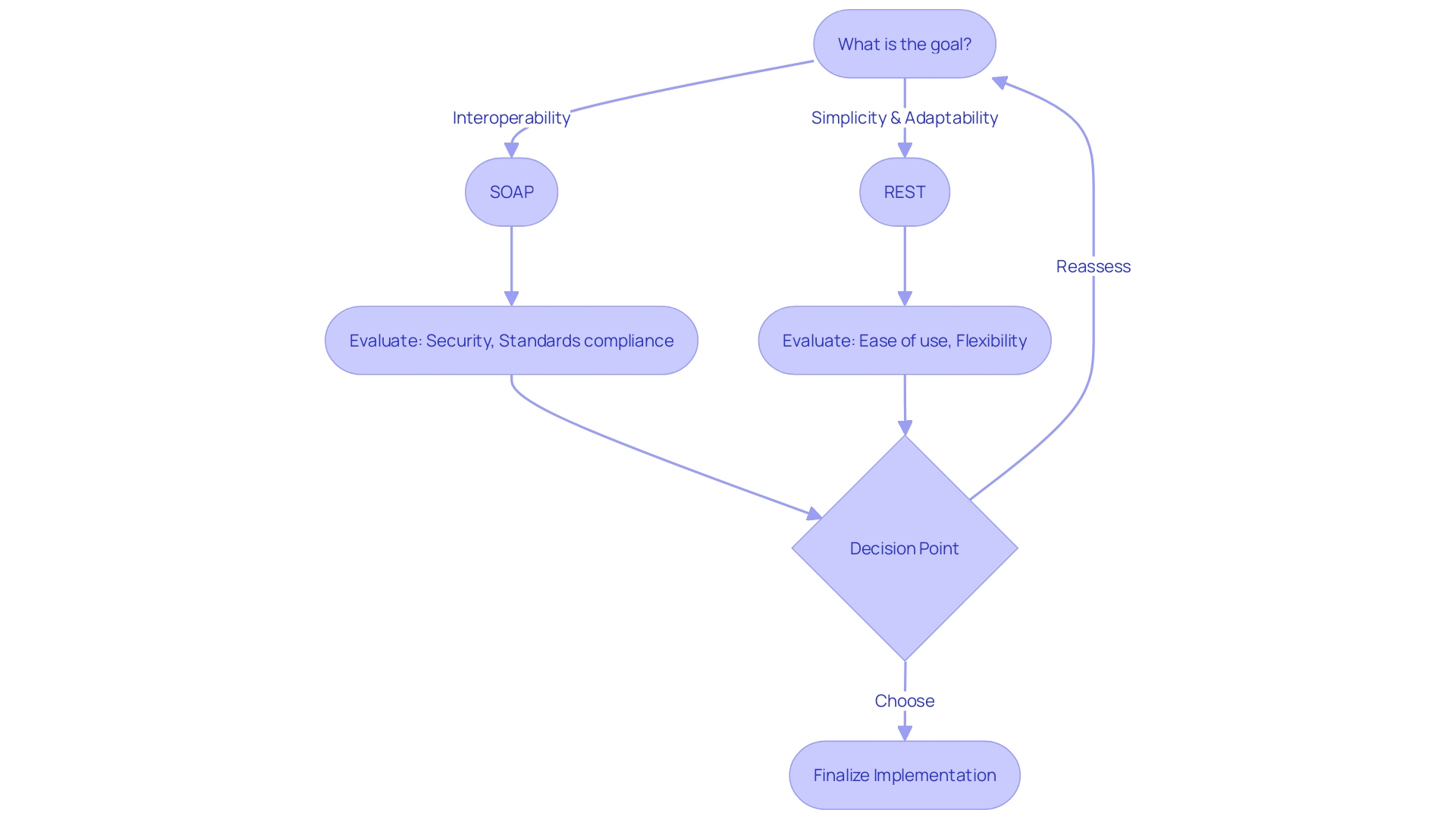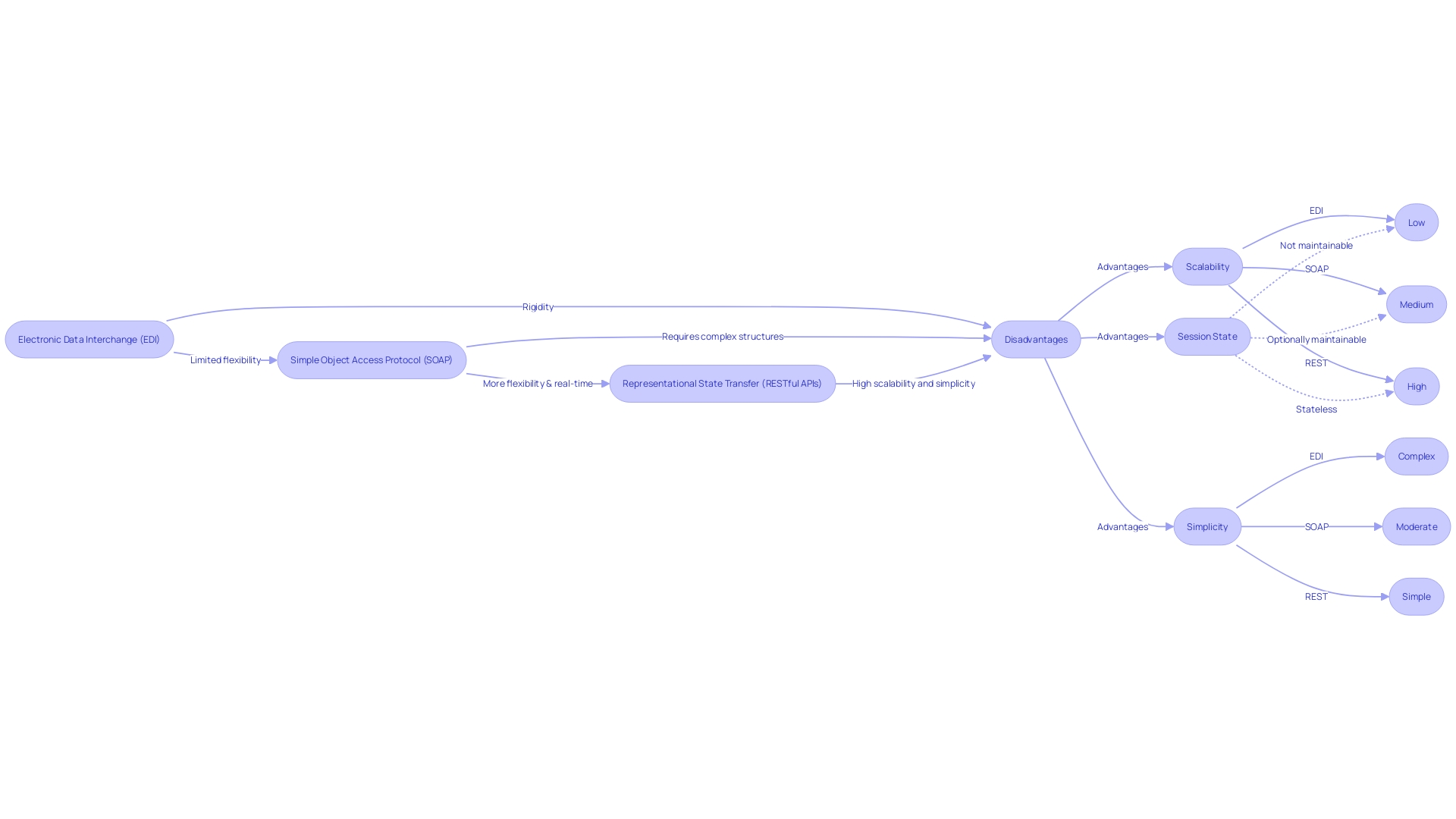Introduction
In the realm of web services architecture, there are two prominent communication protocols: SOAP and REST. SOAP, or Simple Object Access Protocol, is a standardized approach that leverages XML for structured message exchanges.
It emphasizes interoperability and adheres to rigorous standards such as WSDL and XSD. On the other hand, REST, or Representational State Transfer, embodies simplicity and statelessness, operating primarily over HTTP.
Unlike SOAP, REST is flexible in terms of data representation and supports various message formats. The choice between SOAP and REST depends on the specific needs of the project, with SOAP excelling in security and reliability, while REST shines in simplicity, performance, scalability, and adaptability. This article explores the key differences, design considerations, performance, scalability, security, and reliability aspects of SOAP and REST, and concludes with insights on choosing the most suitable protocol for your web service architecture.
What is SOAP?
SOAP, short for Simple Object Access Protocol, serves as an established standard for web service interoperability, leveraging XML to encompass structured message exchanges. It offers compatibility with a spectrum of transport mechanisms, notably HTTP and SMTP, ensuring adherence to rigorous standards such as WSDL, which characterizes the services offered, and XSD to formalize data structures.
This alignment with universal protocols potentiates the collaborative potential of diversified systems, which is a foundational aspect of modern computing. Ellen Ullman encapsulates this sentiment, analogizing that "we build our computers the way we build our cities -- over time, without a plan, on top of ruins."
Indeed, in striving for robust, reliable web services, it's imperative to recognize the propensity for standards and best practices to evolve. As APIs have grown to be omniscient in the digital landscape, defining the ways software components interact, Soap's commitment to enduring interoperability principles is more significant than ever. Aspects such as SAML authentication for single sign-on (SSO) solutions exemplify this commitment. Just as SAML streamlines identity communication between various cloud services, SOAP establishes a coherent platform for XML-based messaging, fortified by widely accepted protocols that enhance communication across heterogeneous software environments.
What is REST?
In the realm of software architecture, REST is a paradigm that embodies the principles of simplicity and statelessness, primarily operating over the well-established web protocols, such as HTTP. What distinguishes REST from other architectural styles, like SOAP, is its flexible adherence to data representation, allowing it to transmit resources—text, JSON, XML—based on the unique needs of the application. This flexibility is underlined by the Hexagonal Architecture approach which emphasizes modularity in design.
Developed by Alistair Cockburn as part of the agile software development movement, the Hexagonal, or Ports & Adapters, Architecture champions the idea of separating core logic from peripheral concerns like user interfaces and databases. This approach not only simplifies testing and maintenance but also enables applications to evolve without shattering structural integrity. Meanwhile, in the larger context, shifting to cloud computing augments Rest's capacity for evolution.
As cloud platforms burgeon, services often need to be composed rather than used in isolation to fully address application requirements. The refined REST philosophy resonates with the sentiment shared by some software developers who question the sanctity of "best practice," arguing that standards evolve and that what is accepted today might not necessarily be the optimal approach tomorrow. This critical reflection emphasizes how innovation must persistently question the status quo to truly remain 'best' in practice.
Key Differences: SOAP vs REST
SOA (Service-Oriented Architecture) manifests through two popular communication protocols, SOAP and REST. Each serves a unique purpose within the web development spectrum. SOAP, characterized by its adherence to strict standards including WSDL and XSD, utilizes exclusively XML for its messaging format.
This rigorous structure caters well to scenarios that demand comprehensive security features such as WS-Security, and its built-in error handling and acknowledgment mechanisms render it particularly reliable for certain enterprise-level applications. REST, on the other hand, represents a more flexible and lightweight alternative. It supports various message formats, including JSON, XML, or plain text, tailoring to the needs of modern web applications where efficiency and speed are paramount.
This protocol takes advantage of HTTP's existing methods, which contributes to its more straightforward and less resource-intensive nature. REST's statelessness is another hallmark, facilitating scalability as no client context is stored on the server between requests. SOAP's complexity may introduce performance bottlenecks, notably due to the overhead of XML parsing and binding with additional protocols such as HTTP and SMTP.
Conversely, REST can enhance system throughput by mitigating such complexities, thereby promoting better resource utilization. Selecting between SOAP and REST hinges on the project specifics and desired attributes. REST reigns supreme for scenarios valuing simplicity, performance scalability, and flexibility, whereas SOAP is the protocol of choice when security and reliability are non-negotiable requirements.
Design
When developers are architecting web services, the choice between SOAP and REST can significantly impact the overall design and functionality. Soap's design is grounded in a formal contract-first approach with WSDL (Web Services Description Language) serving as its underpinning.
This level of structured detail supports interoperability and service discovery. However, this can introduce a degree of inflexibility and complexity, potentially escalating the intricacy of the system.
By contrast, REST advocates a resource-based approach, characterized by simplicity and adaptability. Web resources are identified through URLs and interacted with using standard HTTP methods, which simplifies implementation.
These methodologies not only reflect evolving standards in software development but also mirror the industry's current trends leaning towards more democratic and adaptable tools. The 'State of Developer Ecosystem 2023' report, drawing on insights from over 26,000 global respondents, indicates a tech landscape in flux and increasingly open to innovation – like adopting AI tools, with 46% using GitHub Copilot. These insights prompt reflection on adopted 'best practices' and whether they truly serve the intended purpose or are remnants of bygone traditions. The assertion from industry veterans is clear: the conventions perceived as tried-and-true may be ready for reassessment, as the paradigm of software development continues to evolve with the demands and technologies of the day.

Performance
REST, a time-tested architectural style for networked applications, shines in its efficiency, largely due to its dependency on HTTP - a protocol fundamental to the internet since its inception by Tim Berners-Lee. Lightweight data formats like JSON comprise the typical message structure of REST, providing a speed advantage through simplicity.
Furthermore, REST incorporates the built-in caching mechanisms of HTTP, enhancing performance via quicker response times and diminished network load. In contrast, SOAP, which necessitates XML parsing and additional protocol layers, can incur greater overhead.
This disparity may lead to REST outperforming SOAP in speed and efficiency, particularly vital in the data-driven realm where APIs act as critical conduits for application communication. By enabling seamless interactions between disparate systems, REST APIs not only facilitate data flow but do so with an optimized balance of reliability, efficiency, and scalability. This clear-cut efficiency is essential as we navigate the complexities of API development, striving for applications that remain agile and robust in our increasingly connected world.
Scalability
RESTful services garner accolades for their scalability, which ethers from their stateless operations and robust simplicity. Unburdened by session state, they deftly manage high volumes of requests concurrently.
This efficiency powered Instagram's meteoric rise, bloating from zero to 14 million users with a scant squad of three engineers by leveraging simplicity in their technology stack. Unlike REST, SOAP protocols might buckle under their own heft due to the extra processing required to sustain session states, which may impinge on scalability.
Yet, the road to service architecture is thorny with misconceptions. Pundits caution against conflating microservices with service architecture; the former connotes an unnecessary restriction to size.
Instead, the principles of proper service architecture engagement—a model many modern applications embrace—prioritize rightly scaled, operation-wise services over the miniature scale suggested by 'microservices.' Moreover, the historical flux of data exchange protocols, pivoting from EDI's rigidity to flexible APIs, mirrors the evolution of scalable architectures. APIs encapsulate the modern zest for agile, real-time communication and integration—valued traits in the era of cloud computing. Businesses that have burgeoned since the '60s, thanks to efficient automated systems like EDI, today seek the more adaptable and seamless capabilities that RESTful APIs can offer in the ever-accelerating tempo of global data exchange.

Security
When it comes to security, both SOAP and REST have their own approaches. SOAP provides built-in security features such as WS-Security, which allows for encryption, authentication, and integrity checks.
These security measures are defined at the message level and can provide a higher level of security for sensitive data. REST, on the other hand, relies on implementing security measures at the application level, such as using HTTPS for secure communication and implementing authentication mechanisms. While REST allows for more flexibility in terms of implementing custom security measures, SOAP offers a more standardized and comprehensive approach to security.
Reliability
SOAP protocol's inherent mechanisms for ensuring reliable message delivery differentiate it from RESTful approaches. With integrated error handling, and specific structures for affirming successful message transmission, SOAP provides a robust communication standard, especially suited to operations that demand high reliability. Acknowledgment processes are embedded, aiding in recovery from transmission errors or failures, which is particularly valuable in sectors like healthcare where data integrity is paramount.
Meanwhile, REST relies on the inbuilt HTTP protocol for status indications. For instance, HTTP status codes convey errors, leaving the responsibility for acknowledgment and additional reliability measures to be incorporated at the application layer. This means developers must design REST systems with customized error handling tailored to the application's needs, often using strategies like Webhooks for real-time event notification, aligning with the evolution of data exchange protocols that emphasize flexibility and direct communication such as APIs which have largely superseded older EDI systems.
Advantages of SOAP
When it comes to standard support, Soap's robust compatibility with well-established protocols like WSDL and XSD simplifies the defining and locating of services, adding to its appeal in enterprise environments. Emphasizing interoperability, SOAP insists on a contract-first methodology that ensures seamless interaction among diverse systems. For scenarios where security is a paramount concern, Soap's inherent features shine; it offers comprehensive measures like WS-Security, which provides encryption and ensures authentication and data integrity.
Furthermore, to address the need for consistency and reliability, SOAP integrates error-handling and acknowledgment procedures, enhancing its dependability for crucial applications. Experts recognize that in the life cycle of a research project, the exploration phase can involve rapid ideation and diverse solution-seeking, while exploitation requires the solidification of the top solution into a viable product, and SOAP aligns well with the latter stage. Bearing in mind the complexity and overhead of XML parsing and layering additional protocols, it's clear SOAP suits scenarios with specific requirements for security and reliability, particularly for organizations with distinct research and product divisions.
Advantages of REST
Rest's attributes pave the way for building robust and efficient systems, aligning perfectly with modern software development practices. On the simplicity front, REST earns acclaim for its ease of implementation, offering a straightforward alternative to complex protocols like SOAP.
By harnessing HTTP caching mechanisms, REST delivers enhanced performance, setting a precedent for lightweight message formats that make for rapid and resource-efficient data exchange. Flexibility in data format handling is another cornerstone of REST, empowering developers with the means to drive integration across diverse systems.
This adaptability echoes the philosophy of Hexagonal Architecture, which prioritizes the separation of core logic from peripheral concerns, ensuring that systems are maintainable and receptive to change. Scalability is where REST truly shines; its stateless nature and inherent simplicity facilitate scaling operations to new heights, a vital attribute as the $672 billion enterprise software market continues to surge.
The design aspect of REST is resource-oriented, making for a versatile and intuitive approach to architecture that resonates with modern development processes – from requirements analysis to evolution. Yet, REST is not without its limitations, notably in standard support and security provisions when compared to SOAP. In a fast-evolving industry where low-code development and artificial intelligence tools like GitHub Copilot and ChatGPT are gaining traction – used by 46% and 77% of developers respectively – REST stands as a testament to the continuous innovation and adaptability necessary for the future of software development. These insights are particularly poignant, considering the findings from a global survey of over 26,000 developers, shedding light on the prevailing industry landscape, including language use trends where JavaScript, SQL, Python, and HTML/CSS hold sway. As new insights on software development trends emerge, it's clear that REST, among other technologies, will play a significant role in shaping the experiences of both developers and stakeholders in the software ecosystem.

Choosing Between SOAP and REST
In the realm of web services, the choice between SOAP and REST is guided by the unique demands of your project. With SOAP, you gain a robust protocol that emphasizes standards compliance, interoperability, and reinforced security, making it an ideal ally for projects where these aspects are paramount. REST is the champion of simplicity, offering a lightweight, nimble alternative conducive to building scalable services effortlessly.
A bit like opting for Webhooks over traditional polling, REST sends updates only when there's fresh data to consume, which promotes efficiency. This decision-making process mirrors the meticulous categorization seen in curated news feeds, strategized to deliver content seamlessly, without overwhelming the user. Focusing on project-specific necessities will lead to a discernible choice, ensuring the web service architecture aligns flawlessly with your project's objectives.
Conclusion
In conclusion, SOAP and REST are two prominent communication protocols in web services architecture. SOAP prioritizes security and reliability, adhering to rigorous standards and offering comprehensive security features, making it suitable for enterprise-level applications. On the other hand, REST emphasizes simplicity, performance, scalability, and adaptability, making it ideal for modern web applications.
SOAP follows a formal contract-first approach with WSDL, while REST embraces a resource-based approach, reflecting the industry's current trends towards simplicity and adaptability. REST's reliance on lightweight data formats and built-in caching mechanisms contributes to its speed and efficiency, while SOAP's XML parsing and additional protocols may introduce performance bottlenecks. In terms of scalability, REST's statelessness and robust simplicity enable it to handle high volumes of requests concurrently, while SOAP's session-state approach may limit scalability due to additional processing.
SOAP provides built-in security features, such as WS-Security, while REST implements security measures at the application level, offering more flexibility. SOAP's integrated error handling and acknowledgment mechanisms enhance its reliability, while REST requires customized error handling. Choosing between SOAP and REST depends on the specific project requirements.
SOAP is suitable for scenarios prioritizing security, reliability, and compatibility with established protocols. REST is preferable for projects valuing simplicity, performance, scalability, and adaptability. By carefully considering project needs, the appropriate protocol can be selected to ensure an efficient and seamless web service architecture.
Frequently Asked Questions
What is SOAP?
SOAP, or Simple Object Access Protocol, is a standardized protocol used for web service interoperability. It utilizes XML for structured message exchanges and is compatible with various transport mechanisms, such as HTTP and SMTP. SOAP adheres to strict standards like WSDL (Web Services Description Language) for service definition and XSD (XML Schema Definition) for data structure formalization.
What is REST?
REST, or Representational State Transfer, is an architectural style that emphasizes simplicity and statelessness, primarily using HTTP for communication. Unlike SOAP, REST supports various data formats, including JSON, XML, and plain text, allowing for flexibility based on application needs.
What are the key differences between SOAP and REST?
SOAP is rigid with strict standards (WSDL, XSD) and uses only XML. REST is more flexible, supporting multiple formats (JSON, XML). SOAP has built-in security features like WS-Security, while REST relies on application-level security measures. SOAP includes error handling and acknowledgment mechanisms, making it suitable for applications requiring high reliability. REST is generally more efficient and faster due to its lightweight nature and use of caching.
What are the advantages of using SOAP?
SOAP is advantageous in scenarios that require strong security features (WS-Security), reliable message delivery with built-in error handling, and strict adherence to standards, ensuring interoperability between different systems.
What are the advantages of using REST?
REST excels in simplicity and ease of implementation, support for various data formats, scalability due to its stateless nature, and efficiency through HTTP caching and lightweight message structures.
When should I choose SOAP over REST?
Choose SOAP when your project demands high security and reliability, strict compliance with standards for interoperability, and complex transactions where built-in error handling is necessary.
When should I choose REST over SOAP?
Opt for REST when you need a lightweight and flexible solution, simplicity and speed are priorities, and scalability and resource efficiency are critical for your application.
How do SOAP and REST handle security?
SOAP offers built-in security protocols (WS-Security) for encryption and message integrity. REST relies on HTTPS for secure communication and allows for custom application-level security implementations.
How do SOAP and REST ensure reliability?
SOAP integrates mechanisms for message acknowledgment and error recovery, making it reliable for critical applications. REST uses HTTP status codes to indicate success or failure, placing the responsibility for error handling at the application level.
What considerations should be made when choosing between SOAP and REST?
Consider your project's specific needs regarding security requirements, the complexity of transactions, performance and scalability objectives, and compatibility with existing systems and standards.
How do evolving technologies impact the choice between SOAP and REST?
The rapid evolution of software development tools and practices, such as low-code platforms and AI tools, emphasizes the need for adaptable and efficient solutions. REST's flexibility and simplicity align well with modern development trends, while SOAP may be more suitable for legacy systems or projects requiring stringent security and reliability.




